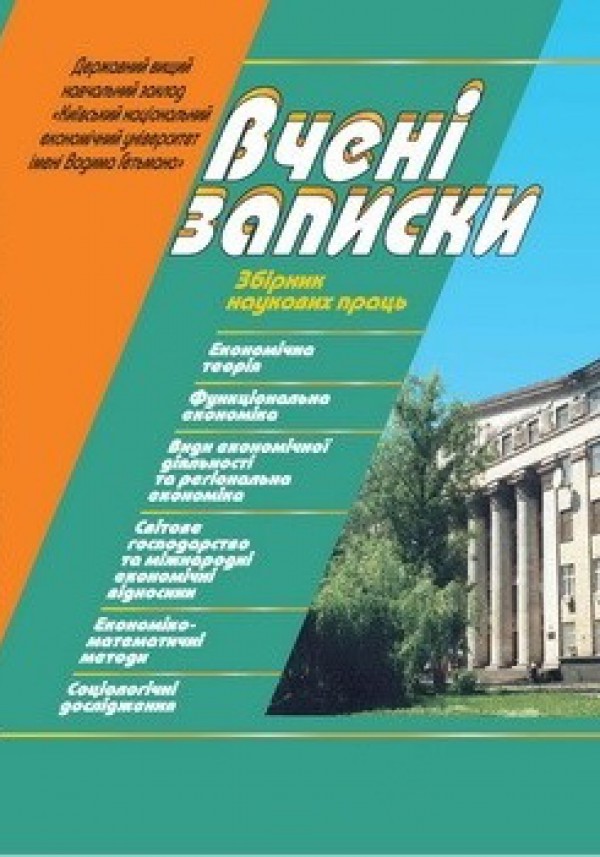
Collection of Scientific Papers "Scientific Notes"
ISSN 2415-8518
Вплив диспропорційності структурних детермінантів на національний інноваційний розвиток
The impact of disproportional structural determinants on national innovative development
DOI:
10.33111/vz_kneu.38.25.01.15.103.109
Анотація: В дослідженні аналізується взаємозв’язок між інноваційною продуктивністю та економічними показниками, досліджуючи структурні асиметрії у рівнях інноваційного потенціалу країн. Використовуючи панельний регресійний аналіз, зокрема моделі фіксованих ефектів та випадкових ефектів, а також їхні розширені версії з логарифмічними перетвореннями та квадратичними членами, в дослідженні виявлено, що зростання ВВП на душу населення та платежі за використання інтелектуальної власності позитивно впливають на рівень інноваційності.
Водночас, у високорозвинених країнах спостерігається спадна віддача від подальших інвестицій у ВВП і технологічну інфраструктуру. Індекси людського капіталу, такі як Індекс працівників сфери знань та Індекс людського капіталу та досліджень, стабільно демонструють позитивний вплив на інновації. Однак інфраструктурні показники, включаючи рівень охоплення ІКТ, показали слабшу значущість, що може свідчити про ефект насичення в економіках із високим рівнем розвитку. Включення нелінійних ефектів підтвердило, що взаємозв’язок між інноваційністю та економічними показниками є складнішим, ніж вважалося раніше, з проявами спадної граничної віддачі. Результати дослідження підкреслюють необхідність цільових інноваційних стратегій, особливо для країн із високим рівнем доходу, які повинні акцентувати увагу на нематеріальних активах, фундаментальних дослідженнях та управлінні інтелектуальною власністю замість фокусування лише на базових інфраструктурних проєктах. Отримані висновки мають практичне значення для розробки політик щодо зменшення глобальних інноваційних диспропорцій через підтримку людського капіталу, інституційні реформи та розвиток ринкової складності. Крім того, результати свідчать про необхідність адаптивних підходів до інноваційної політики, які враховують національні особливості та рівень економічного розвитку, що дозволить країнам ефективніше використовувати свої конкурентні переваги в глобальній економіці.
Abstract: This study examines the relationship between innovation performance and
economic indicators, exploring structural asymmetries in the levels of countries'
innovation potential. Utilizing panel regression analysis, specifically fixed-effects and
random-effects models, as well as their extended versions incorporating logarithmic
transformations and quadratic terms, the research finds that an increase in GDP per
capita and payments for intellectual property positively influence innovation levels.
However, in highly developed countries, diminishing returns from further investments in
GDP and technological infrastructure are observed. Human capital indices, such as the
Knowledge Workers Index and the Human Capital and Research Index, consistently
demonstrate a positive impact on innovation. In contrast, infrastructure indicators,
including ICT coverage levels, exhibit weaker significance, potentially indicating a
saturation effect in highly developed economies. The inclusion of nonlinear effects
confirms that the relationship between innovation and economic indicators is more
complex than previously assumed, with manifestations of diminishing marginal returns.
The findings underscore the necessity of targeted innovation strategies, particularly for
high-income countries, which should prioritize intangible assets, fundamental research,
and intellectual property management rather than solely focusing on basic infrastructure
projects. These conclusions have practical implications for policy development aimed at
reducing global innovation disparities through human capital support, institutional
reforms, and the advancement of market complexity. In addition, the results indicate the
need for adaptive approaches to innovation policy that take into account national
characteristics and the level of economic development, which will allow countries to more
effectively use their competitive advantages in the global economy.
Ключові слова: інноваційні диспропорції, економічне зростання, технологічний фронтир, панельна регресія
Key words: innovation disparities, economic growth, technological frontier, panel data regression
УДК: 339.97
UDC: 339.97
JEL: F15 O32
To cite paper
In APA style
Parubets, S. (2025). The impact of disproportional structural determinants on national innovative development. Collection of Scientific Papers "Scientific Notes", 38 (1), 179-180. http://doi.org/10.33111/vz_kneu.38.25.01.15.103.109
In MON style
Парубець С.О. Вплив диспропорційності структурних детермінантів на національний інноваційний розвиток. Вчені записки. 2025. № 38(1). С. 179-180. http://doi.org/10.33111/vz_kneu.38.25.01.15.103.109 (дата звернення: 26.04.2025).
With transliteration
Parubets, S. (2025) Vplyv dysproportsiinosti strukturnykh determinantiv na natsionalnyi innovatsiinyi rozvytok [The impact of disproportional structural determinants on national innovative development]. Collection of Scientific Papers "Scientific Notes", no. 38(1). pp. 179-180. http://doi.org/10.33111/vz_kneu.38.25.01.15.103.109 [in Ukrainian] (accessed 26 Apr 2025).
.jpg ) # 38(1) / 2025
# 38(1) / 2025
Download Paper
2
Views
0
Downloads
0
Cited by

